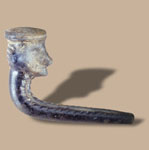|
|
|
Ancient Ontario Smoking PipesThe smoking pipe was a distinctive cultural feature of the pre-contact Iroquoian-speaking peoples in Ontario, including the Huron and their ancestors. Most were made of pottery, but sometimes stone was also used. These pipes show a significant degree of individual craftsmanship, yet still conform to certain socially accepted styles or types, based on bowl shape and decoration, as identified by archaeologists. Pipe stems were sometimes decorated too. Effigy pipes appear in the Ontario archaeological record from about the 14th century until after European contact in the 17th century. Their bowls were modelled into anthropomorphic (human) or zoomorphic (birds, animals, reptiles and rodents) figures, or 'effigies.' Research indicates that the style of zoomorphic figures remained comparatively unchanged over the period. Representations include salamanders, snakes, owls, bears, and wolves or dogs. The most common effigy was the human figure, in particular the face, of which there are many different forms and embellishments. Various interpretations of effigy pipes have been described and published over the last hundred or more years. Their meaning appears to be complex, requiring multiple explanations that are specific to each effigy. Some zoomorphic figures may represent clan or lineage totems, others may be cosmological symbols. Human faces may have an association with medicine mask ceremonies or with powerful or influential individuals. |
Bibliography · Links · Credits · Index


